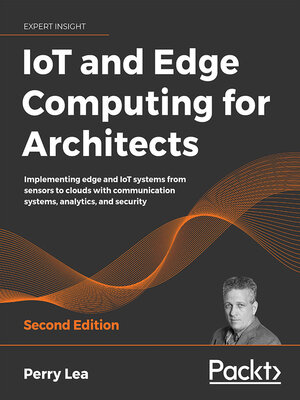IoT and Edge Computing for Architects
ebook ∣ Implementing edge and IoT systems from sensors to clouds with communication systems, analytics, and security
By Perry Lea

Sign up to save your library
With an OverDrive account, you can save your favorite libraries for at-a-glance information about availability. Find out more about OverDrive accounts.
Find this title in Libby, the library reading app by OverDrive.



Search for a digital library with this title
Title found at these libraries:
| Library Name | Distance |
|---|---|
| Loading... |
Create scalable IoT and edge computing solutions with practical architectural strategies, robust communication protocols, and integrated analytics support for informed decision-makingKey FeaturesBuild robust IoT and edge computing systems using real-world architectural strategies Explore a comprehensive range of technologies—from sensors and RF to cloud infrastructure and analytics Gain the insights needed to make informed technical decisions across communication protocols, security, and system design Book DescriptionIndustries are embracing IoT technologies to improve operational expenses, product life, and people's well-being. An architectural guide is needed if you want to traverse the spectrum of technologies needed to build a successful IoT system, whether that's a single device or millions of IoT devices.
IoT and Edge Computing for Architects, 2E encompasses the entire spectrum of IoT solutions, from IoT sensors to the cloud. It examines modern sensor systems, focusing on their power and functionality. It also looks at communication theory, paying close attention to near-range PAN, including the new Bluetooth® 5.0 specification and mesh networks. Then, the book explores IP-based communication in LAN and WAN, including 802.11ah, 5G LTE cellular, Sigfox, and LoRaWAN. It also explains edge computing, routing and gateways, and their role in fog computing, as well as the messaging protocols of MQTT 5.0 and CoAP.
With the data now in internet form, you'll get an understanding of cloud and fog architectures, including the OpenFog standards. The book wraps up the analytics portion with the application of statistical analysis, complex event processing, and deep learning models. The book then concludes by providing a holistic view of IoT security, cryptography, and shell security in addition to software-defined perimeters and blockchains.What you will learnUnderstand the role and scope of architecting a successful IoT deployment Scan the landscape of IoT technologies, from sensors to the cloud and more See the trade-offs in choices of protocols and communications in IoT deployments Become familiar with the terminology needed to work in the IoT space Broaden your skills in the multiple engineering domains necessary for the IoT architect Implement best practices to ensure reliability, scalability, and security in your IoT infrastructure Who this book is for
This book is for architects, system designers, technologists, and technology managers who want to understand the IoT ecosphere, technologies, and trade-offs, and develop a 50,000-foot view of IoT architecture. An understanding of the architectural side of IoT is necessary.
]]>






